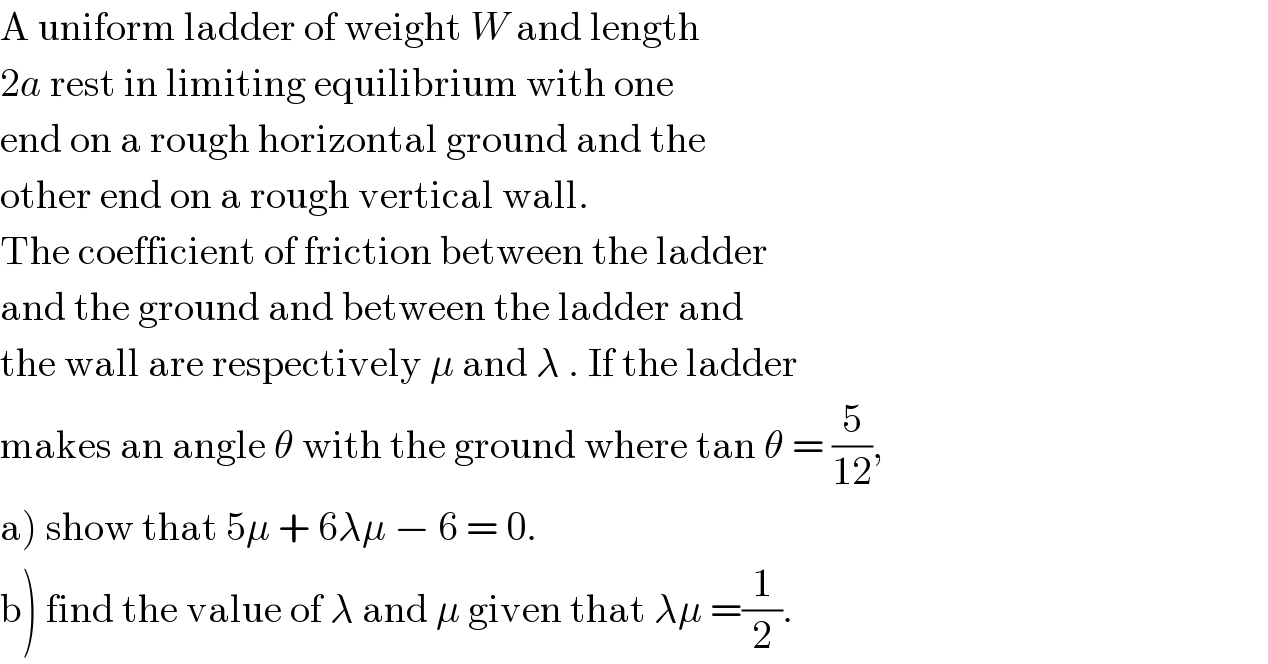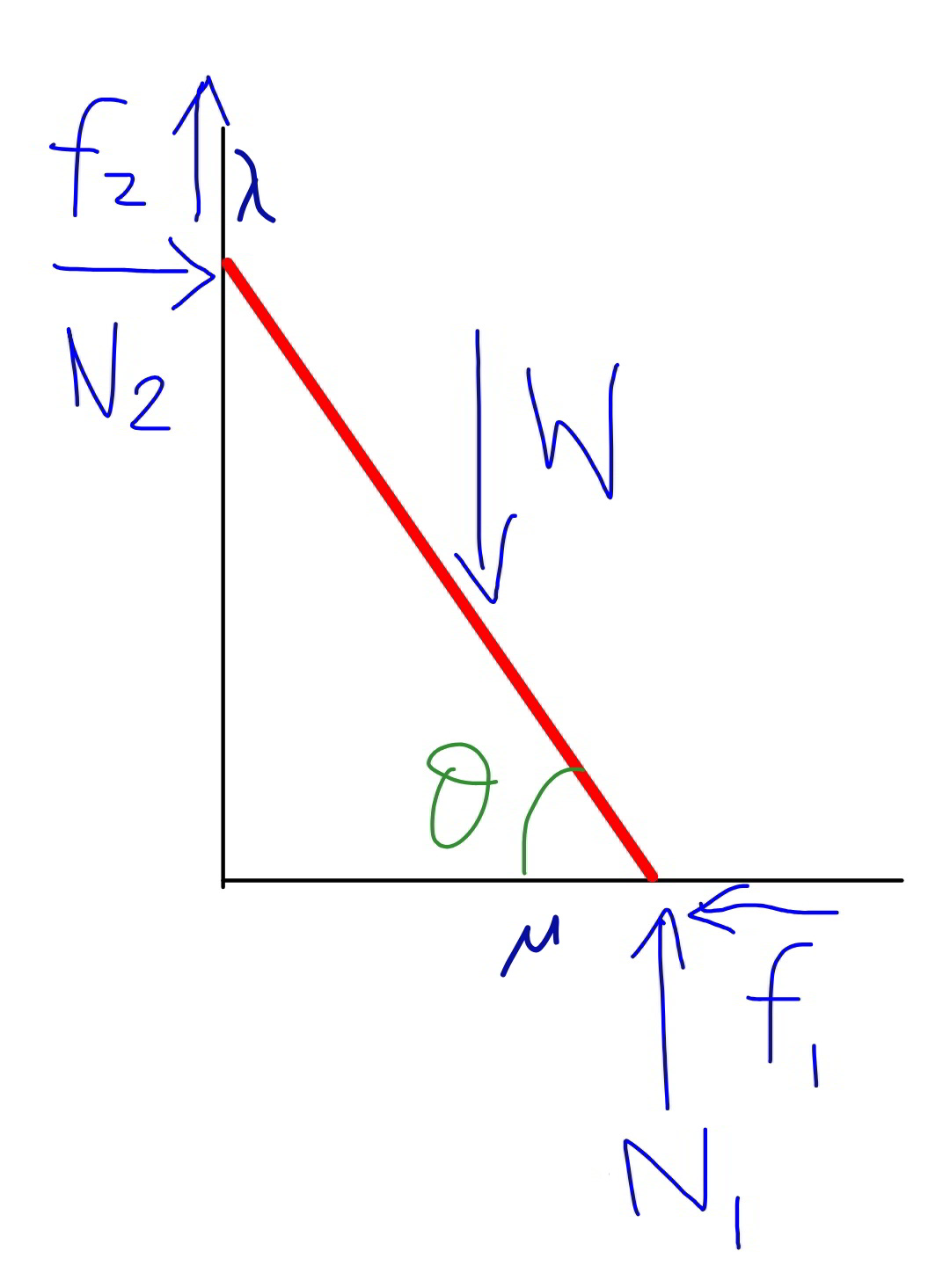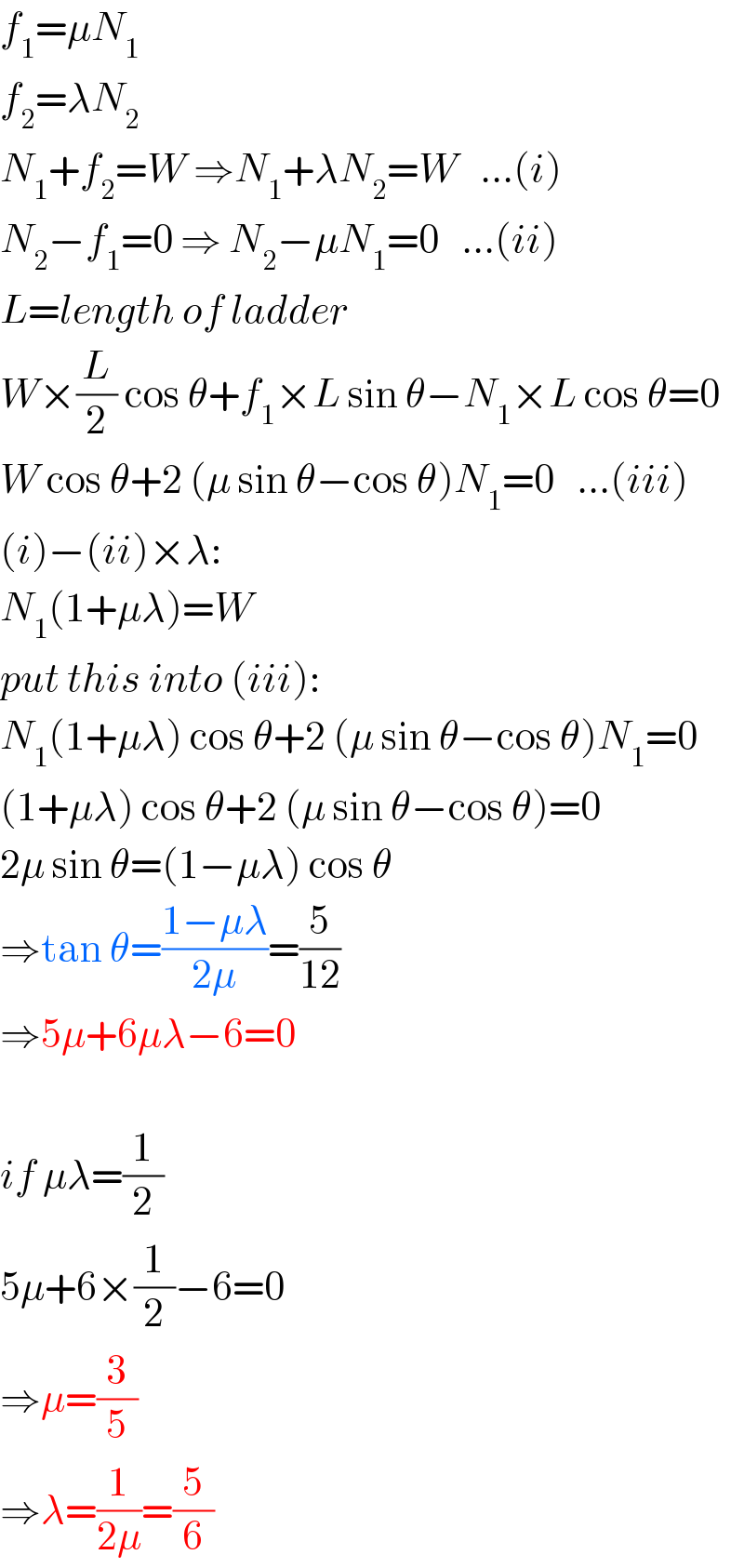
Question Number 76579 by Rio Michael last updated on 28/Dec/19

$$\mathrm{A}\:\mathrm{uniform}\:\mathrm{ladder}\:\mathrm{of}\:\mathrm{weight}\:{W}\:\mathrm{and}\:\mathrm{length} \\ $$$$\mathrm{2}{a}\:\mathrm{rest}\:\mathrm{in}\:\mathrm{limiting}\:\mathrm{equilibrium}\:\mathrm{with}\:\mathrm{one}\: \\ $$$$\mathrm{end}\:\mathrm{on}\:\mathrm{a}\:\mathrm{rough}\:\mathrm{horizontal}\:\mathrm{ground}\:\mathrm{and}\:\mathrm{the} \\ $$$$\mathrm{other}\:\mathrm{end}\:\mathrm{on}\:\mathrm{a}\:\mathrm{rough}\:\mathrm{vertical}\:\mathrm{wall}. \\ $$$$\mathrm{The}\:\mathrm{coefficient}\:\mathrm{of}\:\mathrm{friction}\:\mathrm{between}\:\mathrm{the}\:\mathrm{ladder} \\ $$$$\mathrm{and}\:\mathrm{the}\:\mathrm{ground}\:\mathrm{and}\:\mathrm{between}\:\mathrm{the}\:\mathrm{ladder}\:\mathrm{and} \\ $$$$\mathrm{the}\:\mathrm{wall}\:\mathrm{are}\:\mathrm{respectively}\:\mu\:\mathrm{and}\:\lambda\:.\:\mathrm{If}\:\mathrm{the}\:\mathrm{ladder} \\ $$$$\mathrm{makes}\:\mathrm{an}\:\mathrm{angle}\:\theta\:\mathrm{with}\:\mathrm{the}\:\mathrm{ground}\:\mathrm{where}\:\mathrm{tan}\:\theta\:=\:\frac{\mathrm{5}}{\mathrm{12}}, \\ $$$$\left.\mathrm{a}\right)\:\mathrm{show}\:\mathrm{that}\:\mathrm{5}\mu\:+\:\mathrm{6}\lambda\mu\:−\:\mathrm{6}\:=\:\mathrm{0}. \\ $$$$\left.\mathrm{b}\right)\:\mathrm{find}\:\mathrm{the}\:\mathrm{value}\:\mathrm{of}\:\lambda\:\mathrm{and}\:\mu\:\mathrm{given}\:\mathrm{that}\:\lambda\mu\:=\frac{\mathrm{1}}{\mathrm{2}}.\: \\ $$
Answered by mr W last updated on 28/Dec/19

Commented by mr W last updated on 28/Dec/19

$${f}_{\mathrm{1}} =\mu{N}_{\mathrm{1}} \\ $$$${f}_{\mathrm{2}} =\lambda{N}_{\mathrm{2}} \\ $$$${N}_{\mathrm{1}} +{f}_{\mathrm{2}} ={W}\:\Rightarrow{N}_{\mathrm{1}} +\lambda{N}_{\mathrm{2}} ={W}\:\:\:...\left({i}\right) \\ $$$${N}_{\mathrm{2}} −{f}_{\mathrm{1}} =\mathrm{0}\:\Rightarrow\:{N}_{\mathrm{2}} −\mu{N}_{\mathrm{1}} =\mathrm{0}\:\:\:...\left({ii}\right) \\ $$$${L}={length}\:{of}\:{ladder} \\ $$$${W}×\frac{{L}}{\mathrm{2}}\:\mathrm{cos}\:\theta+{f}_{\mathrm{1}} ×{L}\:\mathrm{sin}\:\theta−{N}_{\mathrm{1}} ×{L}\:\mathrm{cos}\:\theta=\mathrm{0} \\ $$$${W}\:\mathrm{cos}\:\theta+\mathrm{2}\:\left(\mu\:\mathrm{sin}\:\theta−\mathrm{cos}\:\theta\right){N}_{\mathrm{1}} =\mathrm{0}\:\:\:...\left({iii}\right) \\ $$$$\left({i}\right)−\left({ii}\right)×\lambda: \\ $$$${N}_{\mathrm{1}} \left(\mathrm{1}+\mu\lambda\right)={W} \\ $$$${put}\:{this}\:{into}\:\left({iii}\right): \\ $$$${N}_{\mathrm{1}} \left(\mathrm{1}+\mu\lambda\right)\:\mathrm{cos}\:\theta+\mathrm{2}\:\left(\mu\:\mathrm{sin}\:\theta−\mathrm{cos}\:\theta\right){N}_{\mathrm{1}} =\mathrm{0} \\ $$$$\left(\mathrm{1}+\mu\lambda\right)\:\mathrm{cos}\:\theta+\mathrm{2}\:\left(\mu\:\mathrm{sin}\:\theta−\mathrm{cos}\:\theta\right)=\mathrm{0} \\ $$$$\mathrm{2}\mu\:\mathrm{sin}\:\theta=\left(\mathrm{1}−\mu\lambda\right)\:\mathrm{cos}\:\theta \\ $$$$\Rightarrow\mathrm{tan}\:\theta=\frac{\mathrm{1}−\mu\lambda}{\mathrm{2}\mu}=\frac{\mathrm{5}}{\mathrm{12}} \\ $$$$\Rightarrow\mathrm{5}\mu+\mathrm{6}\mu\lambda−\mathrm{6}=\mathrm{0} \\ $$$$ \\ $$$${if}\:\mu\lambda=\frac{\mathrm{1}}{\mathrm{2}} \\ $$$$\mathrm{5}\mu+\mathrm{6}×\frac{\mathrm{1}}{\mathrm{2}}−\mathrm{6}=\mathrm{0} \\ $$$$\Rightarrow\mu=\frac{\mathrm{3}}{\mathrm{5}} \\ $$$$\Rightarrow\lambda=\frac{\mathrm{1}}{\mathrm{2}\mu}=\frac{\mathrm{5}}{\mathrm{6}} \\ $$
Commented by Rio Michael last updated on 28/Dec/19

$$\mathrm{thanks}\:\mathrm{sir} \\ $$
